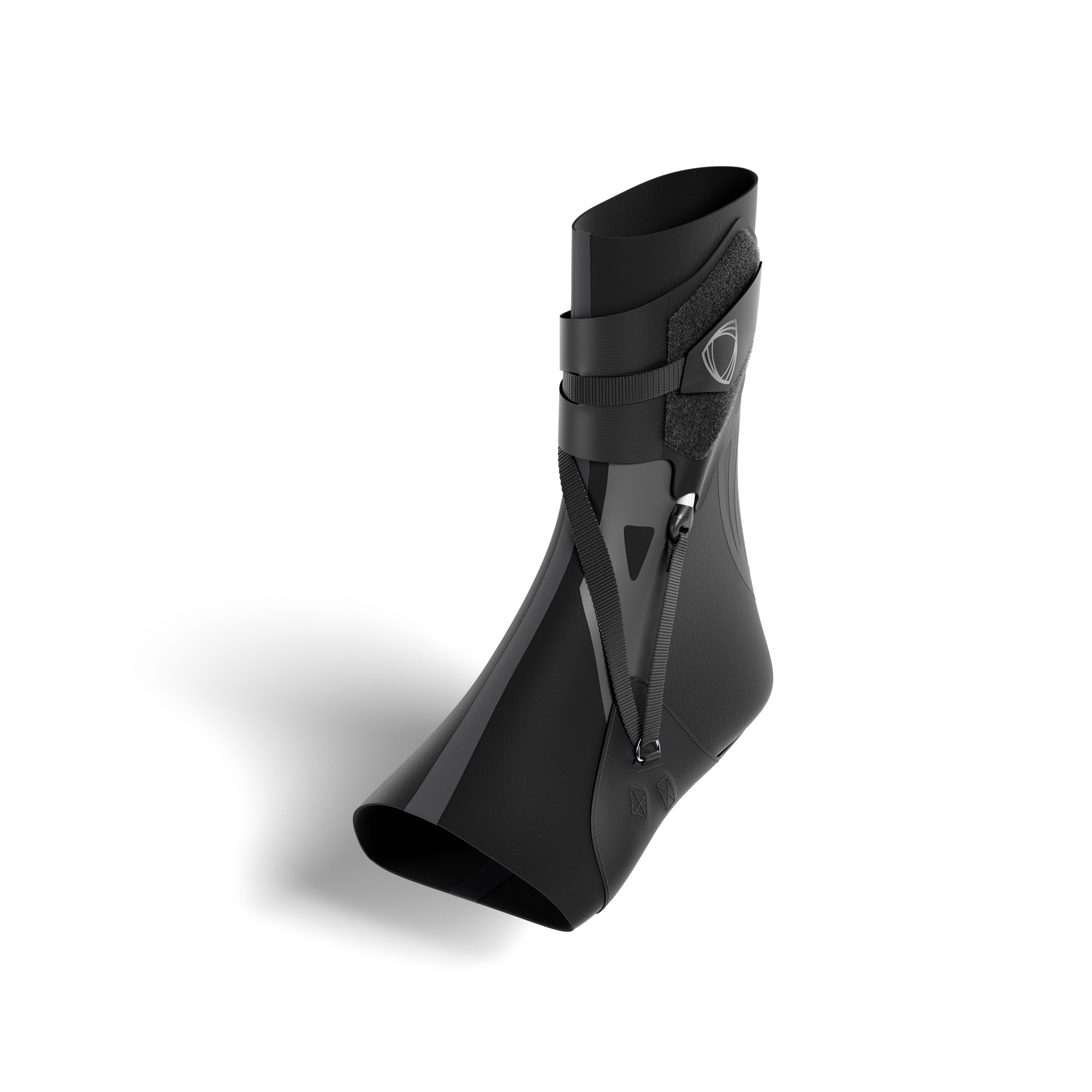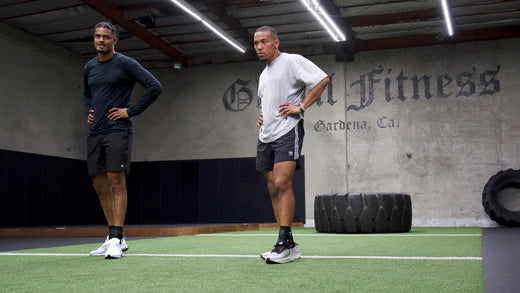Have you twisted your ankle and now have a swollen ankle? Here you can find out everything you need to know about the main causes and symptoms, and get quick tips on how to relieve the swelling. Whether it's after sports, for no apparent reason, or even without any pain, a swollen ankle needs to be treated properly. Find out how to do this here.
Swollen ankles – harmless or a warning sign?
The causes of a swollen ankle range from harmless strain to more serious conditions. Athletes in particular are often affected by swelling, whether due to sprains, torn ligaments, or fatigue. However, other factors such as water retention, illness, or thrombosis can also lead to swelling.
Causes of swollen ankles – overview
The causes of swollen ankles can be roughly divided into two categories:
- Mechanical causes: Sprains, strain, or injuries to the ankle joint.
- Medical causes: Fluid retention, circulatory disorders, diseases such as heart failure or thrombosis.
Swelling on one side often indicates a local cause such as an injury or thrombosis. If both ankles are swollen, this may indicate a systemic disease or fluid retention (edema).
Sports-related causes: sprains, overexertion, etc.
Swelling can occur on both the inside and outside of the ankle. While swelling on the outside often indicates a sprain or torn ligament, swelling on the inside can indicate overexertion or inflammation of the tendon structures.
The ankle joints are particularly stressed and susceptible to injury in sports involving fast movements, jumps, or physical contact.
Common ankle injuries
- Sprain: One of the most common sports injuries is a sprain. This involves overstretching of the ligaments, usually caused by suddenly twisting the foot. Swelling often occurs immediately, accompanied by pain and restricted movement.
- Torn ligament: If the strain is too high, it can lead to a partial or complete tear of an ankle ligament. This causes severe swelling, pain, and instability in the joint.
- Tendon or muscle injuries: Overuse or sudden movements can also affect tendons or muscles. This often manifests itself in persistent pain or sensitivity to pressure.
- Fracture: In more severe cases, a swollen ankle may also indicate a bone injury. A fracture is often accompanied by severe pain, visible misalignment, and an inability to put weight on the foot.
Once injured, the ankle joint often remains unstable. Anyone who returns to training too soon after a sprain or torn ligament, or who does not do specific stabilization training, risks further injury. Without appropriate measures, this can lead to chronic complaints or persistent weakness of the joint in the long term.
Treatment options: How to manage swelling
A swollen ankle is not only uncomfortable, but can also limit mobility and increase the risk of injury. The faster you react, the better you can relieve pain and support healing.
First aid: The RICE rule
In the case of acute sports injuries, the RICE rule helps to quickly control swelling. The four steps—rest, ice, compression, and elevation—support the healing process in the early stages after the injury.
You can find out how to apply the RICE rule correctly and what mistakes to avoid in our detailed article on the subject.

Exercise & Physical Therapy
After the acute phase, it is important to gradually restore mobility to the ankle joint. Complete rest over a longer period of time can lead to weakening of the surrounding muscles, which increases instability.
- Light movements without strain promote blood circulation and support the healing process.
- Targeted physical therapy exercises help to rebuild the muscles and stabilize the joint.
- Coordination and balance exercises train neuromuscular control and prevent further injury.
When to see a doctor for a swollen ankle?
Not every ankle injury heals on its own. A visit to the doctor is recommended if:
- You experience severe pain or bruising
- Your ankle is still swollen or unstable after a few days
- You have limited mobility or a visible misalignment
- The swelling occurs without any apparent cause
In such cases, a medical examination by an orthopedist or imaging such as an X-ray or MRI scan may be necessary to determine the exact cause of the symptoms.
A swollen ankle should not be underestimated—with the right treatment, you can avoid long-term problems and get your ankle back in shape for sports.
The best support for athletes: the innovative ankle brace from Betterguards
After a sprain or ligament tear, proper stabilization is crucial to prevent further injury. However, conventional braces often restrict freedom of movement or do not provide optimal protection at the crucial moment. This is where the adaptive sports technology from Betterguards comes in.

Why The BetterGuard?
The ankle brace from Betterguards combines full freedom of movement with targeted stabilization, exactly when it matters. The technology works like a safety belt for the ankle: while normal movements are possible without restriction, the system intervenes in the event of critical stress and protects your joint from dangerous twisting.
✔ Dynamic stabilization: The brace reacts instantly and stabilizes the joint only when necessary.
✔ Maintains mobility: No restriction in normal movement – your natural range of motion is maintained.
✔ Promotes regeneration: Supports the joint after injuries without passively weakening the muscles.
Many well-known athletes from around the world already rely on Betterguard to support their ankle joints in case of an emergency. Find out more about individual athletes' experiences with our innovative Betterguard here.
- Nils Lichtlein wears The BetterGuard at the 2024 European Handball Championship
- Daniel “Booby” Gibson and our ankle brace for basketball
- Alexander Coßman: 4 years injury-free thanks to Betterguards
With The BetterGuard, you get a brace that doesn't restrict you, but provides dynamic protection – exactly when you need it. This allows you to concentrate fully on your game without fear of re-injury.
Medical causes of swollen ankles
In some cases, health issues such as circulatory disorders, fluid retention, or serious illnesses may be behind the swelling. If the swelling occurs without any apparent cause, persists, or is accompanied by other symptoms, a more detailed examination is necessary.
Thrombosis? See a doctor immediately – unilateral ankle swelling as a warning sign
Thrombosis can be one of the most dangerous causes of sudden, unilateral ankle swelling. This involves the formation of a blood clot in a vein, which obstructs blood flow. If thrombosis is left untreated, the clot can migrate and, in the worst case, cause a pulmonary embolism.
Typical symptoms of thrombosis:
- Swelling on one side of the ankle or lower leg
- Tightness or pulling pain in the calf
- Overheating and redness or bluish discoloration of the skin
People who sit or lie down for long periods of time, for example after surgery or on long-haul flights, are particularly at risk. Smokers, people who are overweight, or those with a genetic predisposition to blood clots also have an increased risk. Anyone who suspects they may have thrombosis should consult a doctor immediately.
Heart failure and water retention (edema)
If both ankles are swollen and there is no external injury or strain, heart failure may be the cause. In this case, the heart is no longer able to pump blood efficiently through the body. As a result, fluid accumulates in the legs, leading to swelling.
Other causes of fluid retention:
- Kidney disease: Impaired kidney function can disrupt the regulation of water balance.
- Liver disease: Damage to the liver often leads to fluid retention in the tissue.
- Medication: Some blood pressure medications, cortisone preparations, or hormonal medications can promote edema.
- Overweight: A high body fat percentage can impair blood circulation and cause water retention in the legs.
Additional symptoms such as shortness of breath, rapid exhaustion, or irregular heartbeat should be taken seriously and clarified by a doctor.
When to see a doctor
A swollen ankle can be harmless, but it can also be a warning sign of a serious illness. A medical examination is advisable if:
- The swelling persists for several days or recurs repeatedly
- Additional symptoms such as shortness of breath, chest pain, or palpitations are present
- The ankle swells for no apparent reason, especially if only one side is affected
- The ankle feels hot, is reddened, or is very painful
Reacting early can minimize health risks and allow possible illnesses to be treated in good time.
Conclusion & prevention tips for healthy ankles
A swollen ankle can have many causes – from overexertion and injuries to serious illnesses. Athletes are particularly at risk due to high levels of stress and rapid changes in movement. However, the risk can be significantly reduced with targeted measures.
What you can do to prevent swelling and injuries:
- Wear suitable footwear: Make sure you wear well-cushioned, sturdy shoes that provide sufficient support for your feet. Worn-out sports shoes should be replaced regularly.
- Warm up before exercising: Dynamic exercises activate the muscles, improve blood circulation, and prepare the joints for stress.
- Targeted training for the ankle joint: Stabilizing exercises strengthen muscles and ligaments, improve balance, and reduce the risk of sprains or torn ligaments.
- Use bandages as intelligent support: Modern bandages such as The BetterGuard stabilize the ankle joint without restricting freedom of movement. They only intervene during critical movements, thus offering targeted protection without passively weakening the muscles.
If you regularly struggle with swollen or painful ankles, it is worth investigating the cause. Recurring complaints can be a sign of insufficient stability or an injury that has not fully healed. In such cases, a medical examination or physiotherapy may be advisable to avoid long-term problems.
Always remember to give your ankle time to heal and take sufficient rest before starting your next training session. Without complete recovery, you will most likely continue to struggle with the injury for a long time. If you still want to continue training actively, try to provide additional support for your ankle and rely on Betterguard.
After the injury is before the injury. Also remember to prevent a swollen ankle. With the right prevention, you will remain fit and protect your ankle joint – so you can concentrate fully on your sport.
Frequently asked questions about swollen ankles
Here you will find the most important questions and answers on the topic of swollen ankles.
What can a swollen ankle mean?
A swollen ankle can indicate a sprain, bruise, or strain. In some cases, it can also be caused by inflammation, venous insufficiency, or damage to ligaments or bones.
What should you do if your ankle is swollen?
Rest, ice, and elevate the ankle immediately (RICE rule). If you experience severe pain, persistent swelling, or bruising, you should see a doctor to rule out any serious injuries.
How long can an ankle remain swollen?
Mild swelling may subside after a few days. If it lasts longer than a week or becomes more severe, you should seek medical advice, especially if walking or standing on the foot remains painful.
What helps with swollen ankles?
Cold, elevation, and light compression help reduce swelling. Movement within the pain-free range promotes blood circulation, while anti-inflammatory ointments or bandages can further support the healing process.




